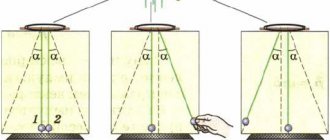Presentation for the lesson “Simple mechanisms” (physics grade 7)
Lesson topic: Simple mechanisms. 7th grade
Lesson objectives:
Educational:
1. Get acquainted with the principle of operation and purpose of simple mechanisms.
2. Consider the types and applications of simple mechanisms.
Developmental:
- Continue to develop students’ thinking by applying acquired knowledge to solving practical problems.
- Continue the development of mental operations: analysis, synthesis, generalization.
Educational:
- Development of communication skills.
- Development of teamwork skills (mutual respect, mutual assistance and support).
Equipment: Computer, projector, screen, ruler - lever, set of weights, blocks, rope.
Lesson plan:
1. Organizational moment.
- Good afternoon. Take the lesson cards on your desks, sign them, mark the option and your mood at the beginning of the lesson.
2. Checking homework.
- Let's move on to checking your homework.
-Answer the test questions on the lesson worksheet.
-Swap with your neighbor, check his solution and give each other marks for the test. (Slide 2)
- Who got an A? Raise a hand. Well done.
-We solve the problem in the work card and on the board.
— Let's check the task. The answer is 12000 J. Raise your hands who has the answer 12000 J. Well done. This is the correct answer.
3. Studying new material.
- Open the workbooks. The topic of our lesson: “Simple mechanisms”. (Slide 1)
How do you think the ancient builders were able to build the Pyramids in Egypt?
The Pyramid of Cheops is 146.6 m high, each side of the base is 230 m, stone blocks weighing 2.5 to 15 tons.
Since time immemorial, people have used various objects and devices - simple mechanisms - to perform work.
Today in the lesson we will introduce you to the main types of simple mechanisms.
(Slide 3).
(Slide 4) The teacher talks about the inclined plane and its varieties:
Wedge (Slide 5)
Screw (Slide 6.7)
— Let’s write down the diagram from the slide in a notebook. (Slide
- Let's consider another type of simple mechanism - a lever.
The teacher demonstrates a ruler-lever, hangs weights, and balances the lever.
Introduces concepts - axis of rotation, fulcrum, arm of force, condition of lever equilibrium.
F 1/ F2 =L2 / L1
Students conclude: the larger the shoulder, the less force must be applied...
Teacher: “A block is a simple mechanism that allows you to change the applied force in direction (fixed block) or in magnitude (movable block).
It is a wheel with a groove around its circumference, rotating around its axis.”
The teacher demonstrates moving and stationary blocks.
If you do not have the necessary equipment, then slides 9 to 13 are shown.
Next, the gate is considered as a type of lever. (Slide 14)
-So, we looked at the basic simple mechanisms. In the modern world, we cannot do without their use. A simple lever mechanism has an important property that determines its widespread use in natural mechanisms, animal and human skeletons. Lever mechanisms in the skeletons of animals and humans are almost all bones that have some freedom of movement: the bones of the limbs, the lower jaw, the phalanges of the human fingers.
Various simple mechanisms that surround us allow us to gain in strength or distance and make our life more convenient. (Slide 15)
Therefore, we need to know and take into account the peculiarities of their action.
4. Consolidation of what has been learned.
-Let's try to apply our existing knowledge to solve problems.
Answer the questions:
- Why is the door handle not attached in the middle of the door, but at its edge?
- If 2 boys of different masses are swinging on a board thrown over a log, should they sit at the same distance from the support?
Let's solve the riddles. (Slide 16)
5. Homework.
- I suggest doing creative homework. Write from the lesson worksheet.
6. Summing up the lesson.
- Let’s summarize the activities for the lesson. Take a work card, grade yourself for the lesson and note your mood. Hand in your work card to your teacher. Use the booklet when preparing your homework.
- This concludes the lesson. Thanks to all!
Levers
Levers
“Give me a foothold and I will move the Earth!”
Archimedes
In this topic we will talk about simple mechanisms used by humanity since time immemorial, and we will dwell in more detail on the most common of them - the lever
.
Previously we talked about mechanical work and power. Mechanical work is a scalar physical quantity proportional to the force applied to the body and the path traveled by the body.
The SI unit of work is
J
(joule).
Power is a scalar physical quantity that characterizes the speed of work.
The SI unit of power is
W
(watt).
Since time immemorial, humanity has used various devices to perform mechanical work. It is known that very heavy objects are quite difficult, and at times impossible, to move directly. However, using a sufficiently long stick, or, as it is also called, a lever
, we can do this quite easily.
If you visit any modern production facility, you can see how the machines work. They, like intelligent beings, press, bend, cut large metal sheets, count and sort, weigh and package various products.
However, if you consider any device of such a complex design, you will notice that its mechanical component is represented by combinations of only six types of simple mechanisms - levers, blocks , screws, wedges, gates
and inclined planes .
Simple mechanisms are also often used in everyday life - an ax, a shovel, scissors, a meat grinder and much more.
Why do we need simple mechanisms?
To answer this question, let's look at a simple example.
Suppose it is necessary to raise a load to a certain height. To do this, you can use one of six simple mechanisms. In all six cases, the force will cause the body to rise.
But this force is not directed upward at all and, with the exception of one case, is not applied directly to the body being lifted.
But the most important thing here is that this force is in all cases less than the weight of the body being lifted
.
This means that the use of simple mechanisms allows you to gain power.
Thus, simple mechanisms
-
These are devices that serve to convert force.
But simple mechanisms serve not only to lift the body. They are used when cutting paper or fabric with scissors, chopping wood, rowing with oars, etc. Moreover, these mechanisms are also present in the human body.
Simple mechanisms have been used by man since ancient times. The imagination of every tourist who visits Easter Island is amazed by the ancient stone sculptures of enormous size located throughout the island. In the creation of these heavy stone sculptures (and on one of them, only the hat has a mass of about 3 tons), simple mechanisms were used when lifting them into a vertical position
. The great Egyptian pyramids were built in a similar way.
One of the most common simple mechanisms is the lever
. It is he who allows a small force to balance a large force. Levers are present in many devices.
What is leverage and how can you gain power by using it?
A lever is any rigid body that can rotate relative to a fixed axis or support.
All levers are divided into 2 types: lever
of the first kind and second kind
.
Lever of the first kind
is called a lever whose axis of rotation is located between the points of application of forces, and the forces themselves are directed in one direction. An example would be scissors, the yoke of equal-armed scales, etc.
Lever of the second kind
is called a lever whose axis of rotation is located on one side of the points of application of forces, and the forces themselves are directed opposite to each other. These are, for example, wrenches, doors, etc.
Under what conditions is the lever in equilibrium?
Let's do an experiment. (We note right away that all the conclusions that we will draw for a lever of the first kind will also be valid for a lever of the second kind). Let's take a 1 meter long ruler as a lever and place it on a fixed support located exactly in the middle. At a distance of 0.25 m from the support, we place a weight weighing 8 N. Naturally, the end of the lever will lower under the influence of the weight of the weight. Now press the free end of the lever with a dynamometer and lift the weight so that the lever is horizontal. In this case, the dynamometer will show a force equal to 4 N.
So why do the unequal forces that are applied to the lever keep it in balance?
This is because the result of the force acting on the lever is determined
not only by its modulus, but also by the distance from the fulcrum to the line of action of the force.
The distance from the fulcrum to the straight line along which the force acts is called
the arm of this force
.
Let us consider the scheme of this experiment.
In addition to the forces F
1 and
F
2, the shoulders of which are designated as
l
1 and
l
2, two more forces will act on the lever - the gravity force of the lever and the elastic force of the support.
As can be seen from the figure, the shoulders of these forces are equal to zero, so they do not affect the balance of the lever. Now let's compare the forces F
1 and
F
2 and their shoulders.
The force F
2 is half the force
F
1, and the arm of the force
F
2 is twice the arm of the force
F
1.
What happens if the arm of force
F 2 is increased, say, by 5 or 25 times?
Then the strength would decrease by 5 or 25 times.
That is, the larger the shoulder, the smaller the force
with which you can lift a load lying on the part of the lever opposite to the support.
The first written explanation of lever equilibrium was given in the third century BC by the ancient Greek scientist Archimedes, who was the first to connect the concepts of force, load and leverage. The law of equilibrium formulated by Archimedes is still in use today and is as follows: a lever is in equilibrium provided that the forces applied to it are inversely proportional to the lengths of their arms.
– lever equilibrium condition
According to legend, realizing the significance of his discovery, Archimedes exclaimed: “Give me a fulcrum, and I will turn the Earth over!”
. True, Archimedes would not have been able to do this during his lifetime. Yes and now too. The thing is that to raise our planet even by one centimeter, an incredibly long lever is required, which would have to be moved for several tens of millions of years at a speed of 1 cm per minute.
Exercises.
Task 1.
At one end of a ruler 100 cm long, a weight weighing 500 g is suspended. In the middle of the ruler at the bottom there is a support, relative to which the ruler can rotate freely. Where should the second mass of 750 g be hung so that the ruler is in equilibrium?
Task 2.
At the ends of a light rod 32 cm long, weights of masses 40 g and 120 g are suspended. Where should the rod be supported so that it is in equilibrium?
Main conclusions:
– Simple mechanisms
, serve to transform the mechanical action on the body, allowing you to change the point of application of the force, its module and direction.
– Simple mechanisms
, like lever, block, gate, wedge, inclined plane and screw are integral parts of the designs of any mechanical devices.
– Lever arm
is any rigid body that can rotate relative to a fixed support or axis.
– Levers
are divided into two types - lever
of the first kind
and lever
of the second kind
.
– Lever of the first kind
is called a lever whose axis of rotation is located between the points of application of forces, and the forces themselves are directed in one direction.
– Lever of the second kind
is called a lever whose axis of rotation is located on one side of the points of application of forces, and the forces themselves are directed opposite to each other.
– Shoulder of power
is the distance from the fulcrum to the straight line along which the force acts.
– Lever equilibrium condition
: A lever is in equilibrium provided that the forces applied to it are inversely proportional to the lengths of their arms.
– Leverage gives gain in power
as many times as the arm of the applied force is greater than the arm of the weight of the load being held.




